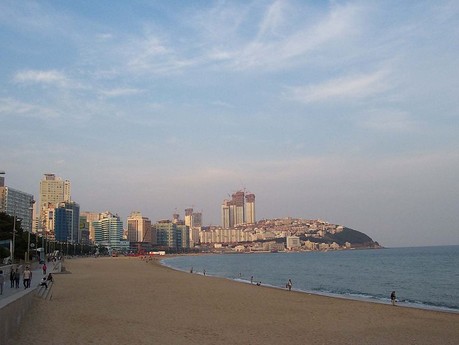Haeundae District is a gu in eastern Busan, South Korea. It has an area of 51.44 km², and a population of about 423,000. This represents about 11.6% of the population in Busan. It became a division of Busan in 1976 and attained the status of gu in 1980.
Haeundae-gu can be reached easily on the subway, Busan Subway Line 2, or by train on the Donghae Nambu railway line from outside of Busan. Both Haeundae subway and train stations are built adjacent to each other.
Haeundae is an affluent beach front community that attracts tens of thousands of Korean tourists and foreigners to what many consider to be Korea's best beach. It has been subject to considerable commercial development in the past decades.
History
Haeundae takes its name from the ninth century Silla scholar and poet Choi Chi-won (literary name Haeun, or "Sea and Clouds"), who, according to a historical account, admired the view from the beach and built a pavilion nearby. A piece of Choi's calligraphy, which he engraved on a rock at Haeundae, still exists.
Haeundae used to be isolated from the large communities in Busan and Busanjin. It remained undeveloped, as did its beach, until the late 1970s and early 1980s. A small number of luxury hotels were constructed when new emphasis was placed on development of the area around the beach after the 1988 Seoul Olympics. More hotels and other tourist facilities have been constructed on the beach-front area since the mid-1990s, and shopping malls and movie theatre complexes have been built in the 'centre' of Haeundae: an area between Haeundae Station and the beach. The area's reputation and prosperity have continued to grow, except briefly during the Asian financial crisis of 1997.
Haeundae's geographical assets, along with its tourist facilities, have led to a regular role as one of the host venues for the annual Busan International Film Festival (BIFF), and Haeundae's Dongbaek Island was the location for the 2005 APEC Conference.
Haeundae New Town (해운대 신시가지-Haeundae Sinsigaji), a major commercial and residential redevelopment project begun in 1990, is located in the Jwa-dong area. This area lies in the southern shadow of Jangsan mountain to the north, and is bounded in the south by Haeundae Station on the Dalmaji Gogae line of the Korean National Railroad. Another development project, Centum City, has been ongoing since early 2000 and is now a major feature of Busan. Its BEXCO (Busan Exhibition and Convention Center) has become a popular venue for international conventions and exhibitions. Marine City, located nearby, is constructed on land reclaimed from the sea, and has several huge, high-rise apartment blocks. Additional apartment blocks, the most modern in Busan, are under construction, with water resorts and related facilities, for use by the public, also planned for Marine City.
Haeundae Beach

Haeundae Beach in Haeundae-gu is located at the southeast end of the city of Busan. Haeundae beach is only 40 minutes away from Busan's main railroad station (in the Downtown area), and less than one hour from Gimhae International Airport. Along the 12 km of coastline is Busan's most popular beach, and with Seogwipo's, it is one of the most famous beaches in South Korea. Because of its easy access from downtown Busan and the famous beach atmosphere, the beach is busy year round with several kinds of beach festivals and visitors from in and out from the country. Dongbaekseom (Dongbaek Island), located at the south end of the beach, offers a view of the sea by car and its coastline is famous for fishing. Oryukdo (Oryuk Islets), a symbol of Busan to many Koreans, can be seen in the distance from Dongbaek Island. During the hot summer months (late July to early August when most Koreans take their summer vacation), Haeundae beach becomes heavily crowded into a virtual human wall with thousands of people and parasols packed into a mile of sand. Visitors to the beach come from all over South Korea as well as outside of Korea. Haeundae is home to majority of expatriates currently residing in Busan.
There are many beach-related cultural events in Haeundae. Along with Geumjeongsan and Dalmaji (Greeting of the Moon) Gogae, Haeundae is one of the most popular spots in Busan to view the first sunrise of the year on January 1, with around a thousand gathering before dawn. Also, a famous beach event occurs in the first week of January when the temperature is around 0°C, the "Polar Bear Club." This event has occurred annually at the Choseon Beach Hotel since 1988. During the 2006 FIFA World Cup match between South Korea and Togo over 50,000 spectators filled the beach to cheer for the Korean team on a giant projector screen.[4] The Nurimaru, pure Korean meaning for Nuri (World) and Maru (Peak or top) was developed in preparation for the 17th APEC(Asia pacific Economic Cooperation) summit on Nov 18-19 in 2005, as the conference hall for APEC. The building is three-stories high and is located on the tip of Dongbaek Island. The ceiling of the Nurimaru is modeled after Seokguram, the famous Buddhist temple in Gyeongju.

Log in to write a comment